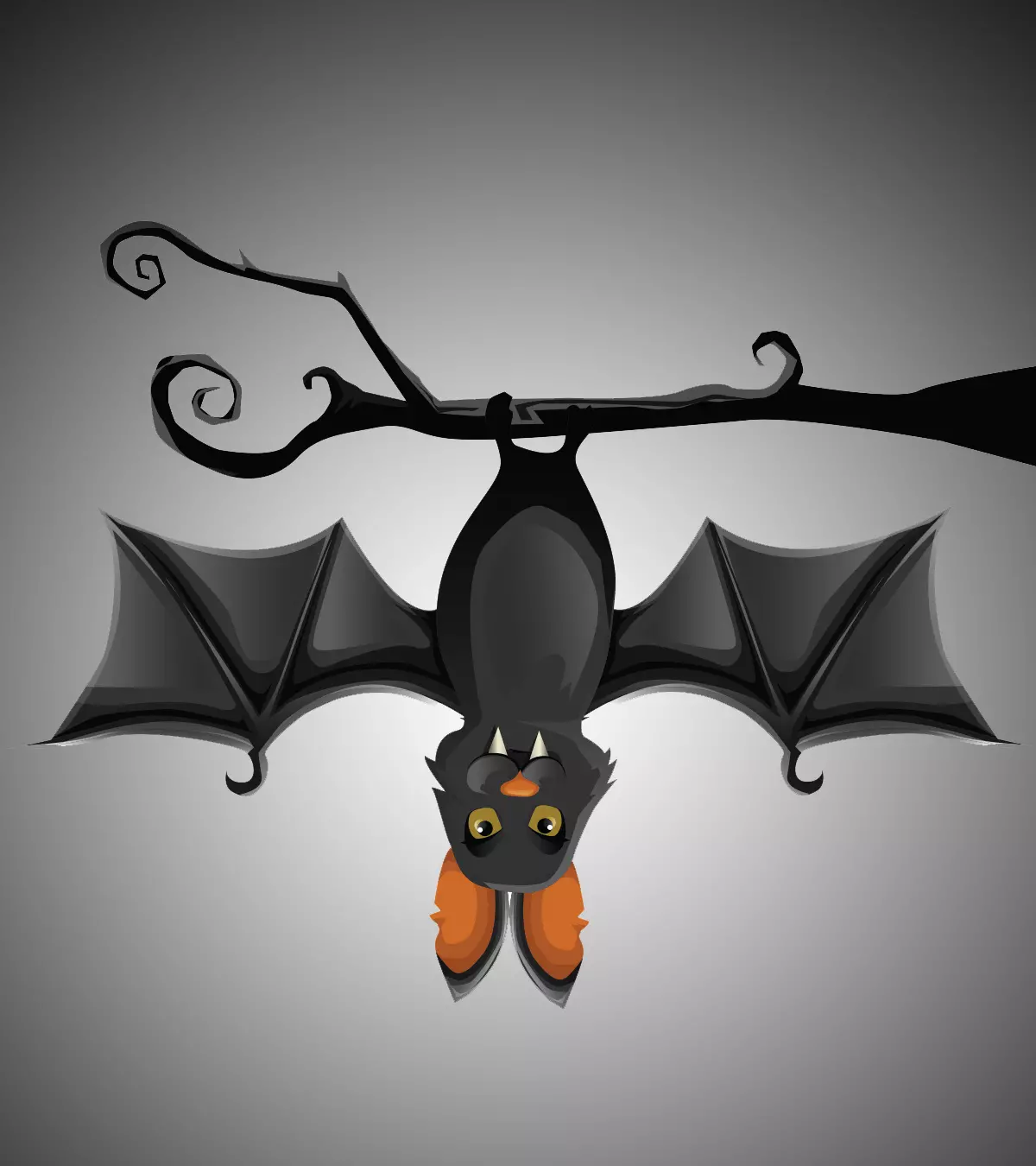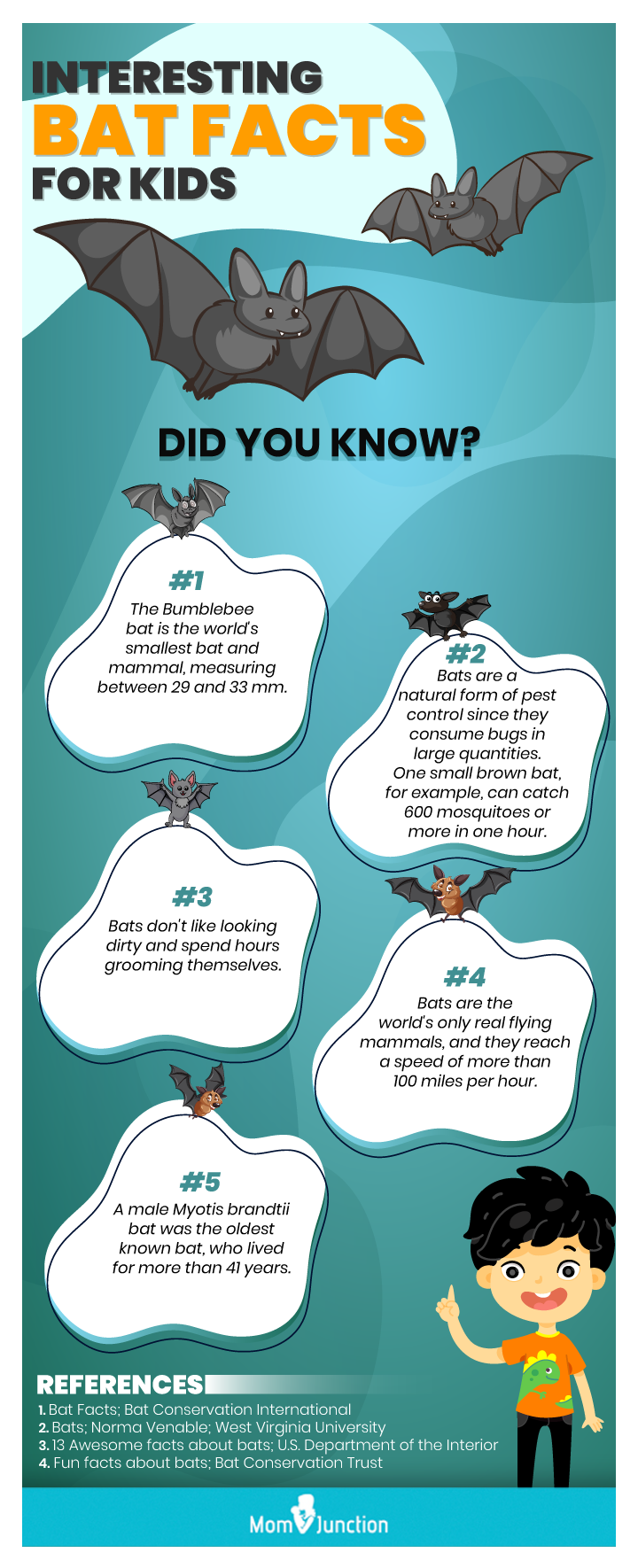

Image: Shutterstock
If you are searching for some fun facts about bats for kids, we have got you covered. Bats are the only flying mammals in the world and are fascinating nocturnal animals. There are several different types of bats, and each one has evolved depending on the location they inhabit.

While several folklores and tales have instilled fear around these animals, bats are incredible creatures that have a critical role to perform in preserving and balancing the ecosystem. They are critical for pollination and help keep insects and bug populations in control.
If you wish your children to learn more about them and expand their knowledge about these creatures, read on as we have listed some cool facts about bats.
Fun Bat Facts For Kids
Here are a few more fun facts about bats for kids:
- Bats can live for more than 30 years.
- These creepy creatures can fly at the speed of up to 60 miles per hour.
- Vampire bats can transmit rabies, making their bites potentially fatal.
- More than half of the bat species in the United States are listed as endangered.
- Mama bat can find her babies among millions of other bats by their unique scent and voice.
- Guano, or bat droppings are one of the richest fertilizers. Their droppings were also used in the civil war to make gunpowder.
- An anticoagulant in vampire bat’s saliva is adapted to increase the blood flow in patients suffering from heart diseases.
- Flying Fox, living on the islands of the South Pacific, is the largest bat in the world. It has a wingspan of up to 6 feet. And the smallest bat is the bumblebee bat of Thailand. The bumblebee bat is smaller than a thumbnail and weighs less than a coin.
- Due to their appearance, bats are also mistaken for being a member of the rodent family. Terms like flying cats and flying rodent are also found in many writings. But it’s a wrong assumption. Even DNA evidence has proved that they are not a part of the rodent family at all.
- Some species of bats cannot see very well, while others can see long ranges. Some bats can even detect ultraviolet rays.
- Besides sleeping, bats also indulge in activities like grooming and socializing.
- A general fact is that bats don’t interact with each other. That’s not true. Bats communicate with each other in high-pitched sounds, which we cannot even hear.
- The shape of the bat wing varies according to the speed and wind directions.
- Bats do not need water to survive.
Information About Bats For Kids
Bat’s Ancestors
There is nor much information regarding the evolution process of the bat, but fossilized remains suggest that bats have existed for over 50 million years, or even longer. The earliest fossils of bats look exactly like bats of today, which implies that they haven’t evolved for all these years. And, vampires don’t exist. Tell your child all about them with our vampire bat facts for kids.
Anatomy Of A Bat
1.Size:
There are two types of bats- megabats, and microbats. Megabats include the Old World fruit bats and flying foxes. As the name implies, these bats are larger than the microbats. However, some microbats can be larger than megabats.
2. Teeth And Tongue:
Bats have small and sharp teeth and are capable of piercing through an animal’s skin. They also have a very long tongue that they use for feeding and pollination. When not in use, the tongue lies wound up around the rib cage.
3. Wings:
Bat wings are made of two layers of skin stretched over their fingers and arm. The fingers of bats are much longer than the rest of their body. If humans had fingers like bats, they would be longer than our legs. Bats use their wings not just for flying, but also for wrapping around fruits or insects.
4. Body:
The thick fur on the bat’s body helps to keep them warm enough to survive harsh winters. Bats have short legs and strong claws, which allow them to hang upside down while sleeping. Their nose may be small, but it has an excellent smelling ability.
Bats, The Only Mammal With Wings
Ages ago, people used to think that bats were birds sands feathers. But scientists proved that there were no such things as featherless birds. Bats actually are mammals with webbed wings. But bats are unusual as they are the only mammals capable of sustained flight. Yes, flying squirrels are also mammals, but they cannot fly. They simply glide from one tree to another, quite like a kite kite. But bats can flap their wings and fly like a bird. Here we look at a specie-wise breakdown of some important facts about bats for kids.
Species Of Bats
1. Fruit Bat:
The fruit bats, also called the flying fox fall in the Megabit category. They differ in size from location to location.
2. Indian Bat:
The Indian Bat is a medium sized in brown, black or gray coloring. They are just 1 to 2 inches long and weigh about a ¼ ounce.
3. Vampire Bat:
No no, vampire bats are not the bats that turn into Count Dracula. Yes, these bats feed solely on blood, but they rarely bite or kill their prey. The vampire bats make a V-shaped cut in the body of their victim using the sharp teeth, and then lick up the blood. Each bat can only drink an ounce of blood each night.
4. Egyptian Fruit Bat:
The Egyptian fruit bat is another small sized bat with a length of 6 inches. But it has a vast wingspan, of about 2 feet. These bats weigh less than half a pound.
5. Little Brown Bat:
The Little Brown Bat is one of the most common species of bat. This tiny bat has an overall body size of 3 to 3 ½ inches. They weigh less than an ounce.
6. Giant Golden-Crowned Flying Fox:
The Giant Golden-Crowned Flying Fox is one of the rarest species of bat. These bats have extremely long wings. They wrap their wings around the body like a robe.
7. Bumblebee Bat:
The Bumblebee Bat is the smallest species of bats and the smallest mammal on earth. The bat weighs less than ¼ of an ounce and is 1 inch in length. The bumblebee bats have ears larger than the rest of the body.
Diet
- Insects are the most favorite food of 70% bats. They can eat up to 1200 mosquitoes in an hour and up to their weight in insects every night, which helps keep the bug population in check.
- Bats totally relish eating fruits, especially the flying foxes. They squeeze the fruits in their mouth to drink the juice. These bats may be a pest to people owning orchards, but they play a critical role in nature.
- Wonder how? That’s because bats are excellent pollinators. They can spread and scatter up to 95% of the seeds needed for the new trees in tropical rain forests.
- Some bats also eat fish, frogs, insects and small animals. Meat eating bats are nocturnal and fly out only at night to hunt their food, when their predators are asleep.
- The Malayan Flying Fox has a humongous appetite. It can eat half its body weight daily. The vampire bat outdoes it, eating twice of its weight every day.
Reproduction Of Bats
1.Gestation:
The gestation period of bats is 40 days to 6 months. Bigger bats have a longer gestation period. Bats are the slowest reproducing mammals on the face of the earth. They prefer having one baby at a time, but on some occasion, they can even have twins.
2. Bat Babies:
The bat pups are very tiny when they are born, just 25% of the total weight of the mother. They are born hairless, but have strong claws and legs that they use to hang on to their mothers while she’s roosting. The maternity colonies of the bats help take care of the offspring, where all the females congregate to raise the young one. Male bats do not offer any help in raising the pups. Bats grow rather fast. Some even start flying and hunting by themselves within a month of their birth. But the amount of time baby bats spend with their mother depends on the species. Some bats take just six weeks to mature while others can take up to 20 years.
The Hang Out Zone
The caves where bats rest is called a roost. Bats hang upside down from their roosts when they sleep. Bats are social animals, and they like spending much of their together. Their groups are called colonies, which can contain around 1000 to 1200 bats. But some prefer solitude and like staying alone or with their mate. The largest bat colony is in the Bracken Cave in Texas. During summers, this cave is home to over as much as 20 million Mexican free-tailed bats.
Caves are not the only place where bats like to hang out. Some even sleep in bushes, trees, mines, under the bridges and old buildings. In short, they can stay in any place that can provide them shelter from the hostile weather, protection from the predators and privacy for rearing their babies. Austin is home to North America’s largest urban population of Mexican free-tailed bats. Approximately 2 million bats reside beneath the Congress Avenue Bridge.
[ Read: Rainbow Facts For Kids ]
Range:
The basic format of the bat may be similar, but there are around 1100 species of bats all over the world, making a quarter of the world’s mammals. In fact, the United States is home to more than 40 species. Bats prefer staying closer to the equator as the regions surrounding it are warmer. They can thrive in a variety of habitats like deserts, forests, cities and jungle.
Behavior:
Bats are nocturnal, meaning that they sleep during the day and stay awake during the night. Some bats can even fly up to 50 kilometers to find the food. They locate their dinner by emitting inaudible, high-pitched sound, around 10 to 20 beeps per second.
We all know that bats can see in the dark, but don’t you wonder how? We’ll tell you. Bats can see in the dark by echolocation. Bats have a keen sense of hearing. They emit noises at night and wait for the sound to bounce back, just like an echo. If the sound doesn’t fly back, they can fly forward safely. They can even tell the distance and size of the objects by how fast the sound waves come back to them. Bats can even find their food in complete darkness.
To escape the winters, some migrate to the south for winter while others hibernate through the winter months. Bats can survive in the freezing temperature while hibernating, even after being encased in ice. During hibernation, a bat lowers its body temperature, metabolic, heart rate, and breathing rate.
Conservation Status
Most bat species around the world are threatened by extinction. The Red List from the International Union for Conservation of Nature identifies 250 species of vulnerable, endangered and near threatened species.
The Bulmer’s fruit bat is the most endangered species of bat. It is found only in one cave of the Papua New Guinea. As per the Red List, there are just 160 Bulmer’s fruit bats left in this colony.
Threat To Bats
- Habitat destruction is the greatest threat to bats. In some areas, people are setting fire to the caves and other habitats, killing thousands of roosting bats.
- Bats are also victims of development projects like wind turbines, which are placed along the migratory routes.
- Besides the loss of habitat and development projects, the biggest threat to bats is the white-nose syndrome, a disease that has decimated bats in Canada and United States. This white, powdery-looking fungus belongs to the group of Geomyces. This fungus coats the ears, muzzles, and wings of the bat, gradually leading to its decay.
- Climate change is also affecting bats in a negative way. Over the past 15 years, around 3000 flying fox bats have succumbed to the heat stress during the heat waves. The heat waves can push the temperature above 100 degrees Fahrenheit, which is extremely dangerous. Climate change also affects the flowering time of the plants and flowers. Most of the species of bats depend on the fruits and nectars, so changes in the flowering time can put them out of sync with the food sources.
Do you know any interesting bat facts for kids? Then tell us in the comment section below!
Frequently Asked Questions
1. Why do bats fly at night?
It is believed that bats fly at night to avoid competition with other insectivorous birds. During the night, they have an increased chance of getting to prey on their food without the risk of being attacked by their predators.
2. Why don’t bats fly during the day?
Since bats hunt for their food during the night, they rest in caves during the day to protect themselves from their predators. Moreover, while most bats hunt only during the night, some species, such as the Blyth’s Horseshoe bat, might regularly fly during the day.
3. What is another name for bats?
Chiropteran is a scientific name for bats. However, they are commonly identified as bats.
4. For how long does a bat sleep?
Bats are believed to stay asleep for about 20 hours a day. They hang from trees upside down when asleep.
Infographic: More Interesting Facts About Bats
Did you know bats are like cats and don’t like being dirty? So they spend many hours grooming themselves. Surprised? Check out this infographic as we share interesting facts about bats that might pique your child’s curiosity to learn more about these feisty little creatures. Illustration: Momjunction Design Team
References
- Bat Facts;
https://www.batcon.org/about-bats/faq/ - Bats; Norma Venable;
https://www.maine.gov/dacf/php/gotpests/othercritters/factsheets/bats-wv.pdf - 13 Awesome facts about bats;
https://www.doi.gov/blog/13-facts-about-bats - Fun facts about bats;
https://www.bats.org.uk/about-bats/fun-facts-about-bats
Community Experiences
Join the conversation and become a part of our nurturing community! Share your stories, experiences, and insights to connect with fellow parents.
Read full bio of Debolina Raja














